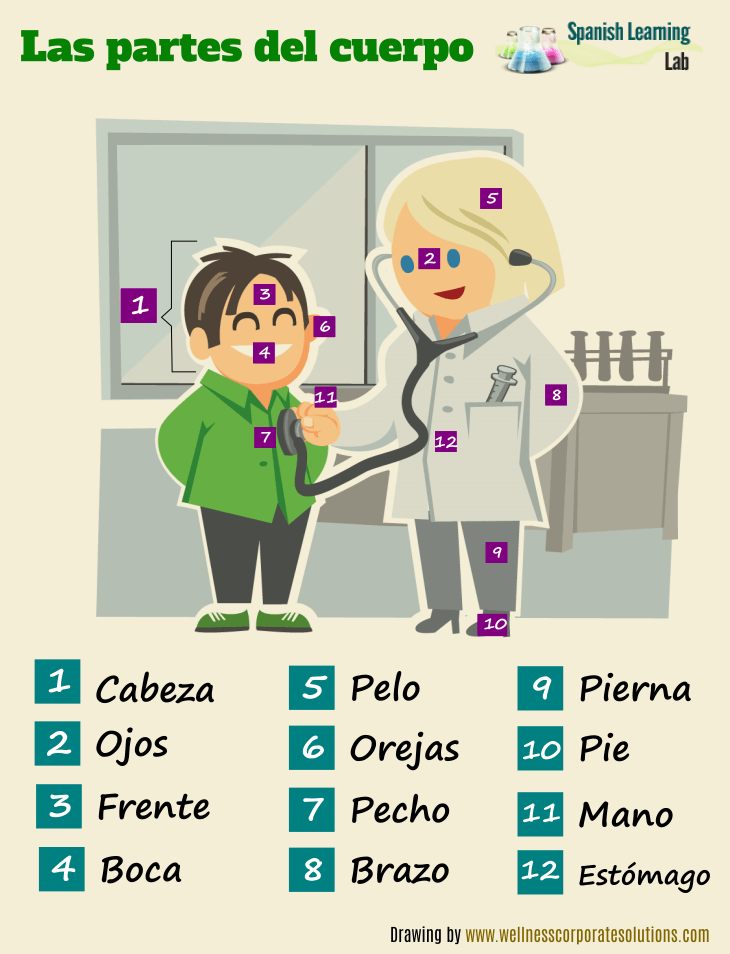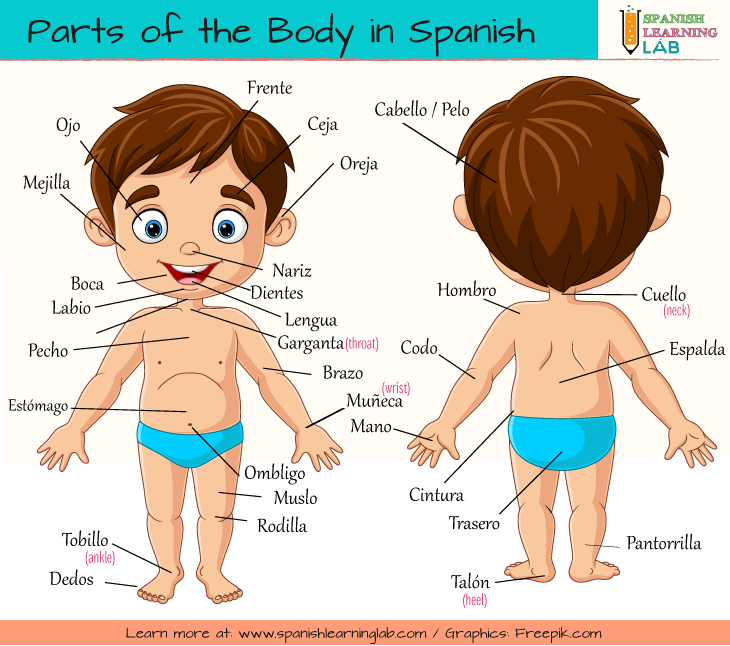This lesson will cover some common words for body parts in Spanish. You will also learn some common verbs associated to the human body and the right way to use them in meaningful expressions. Moreover, you will be able to practice with two Spanish listening activities and quizzes. Let’s start…
Vocabulary: Body parts in Spanish – Las partes del cuerpo
The human body (el cuerpo humano) has so many parts that we would need lots of lessons to introduce them. However, we won’t normally talk about all of them unless we are studying anatomy (anatomía). With that said, we will introduce some words for parts of the body in Spanish that you will often hear in conversations. Check the image below and find out how many of these you already words you know.

As we mentioned before, the vocabulary on this topic is somewhat broad. The previous words are definitely essential, but if you do want to learn a few more, here is a very nice picture illustrating most of the body parts and their names in Spanish, at least the ones for everyday conversations. The more you can memorize, the better because they could help you in real situations like a visit to the doctor or any time you need to talk about your body.

Online vocabulary practice
Look at the pictures again, and then write each of the body parts illustrated on the interactive vocabulary flashcards below.
Phrases and verbs for talking about parts of the body in Spanish
Now, we will focus on using the vocabulary for body parts in Spanish in real situations. First, we will often use these verbs when talking about the human body in Spanish:
“Servir” (useful for…), “Ver/Mirar” (to see), “Mover” (to move), “Levantar” (to raise), “Sostener” (to hold/grab), “Caminar” (to walk), “Comer” (to eat), “Beber” (to drink) and “Respirar” (to breathe).
Here are some examples using these and other verbs to talk about the human body in Spanish. Click on PLAY to listen to the examples.
|
Me gusta mucho el color de sus ojos.
I really like the color of his eyes.
|
|
Me duele la cabeza ¿Tienes alguna pastilla para el dolor?
I have a headache. Do you have any pills?
|
|
En anatomía, la frente es la parte frontal de la cabeza.
In anatomy, the forehead is the front part of the head.
|
|
¿Puedes abrir la boca?
Can you open your mouth?
|
|
Necesito un corte de pelo – Si quieres, yo te lo puedo cortar.
I need a haircut – If you want, I can cut it for you.
|
|
Ese muchacho tiene las orejas muy grandes.
That boy has very big ears.
|
|
¿Te duele el pecho al respirar profundo?
Does your chest hurt when you breathe deeply?
|
|
Levanta este libro con el brazo. Lo debes sostener por 10 segundos.
Raise this book with your arm. You must hold it for 10 seconds.
|
|
Mueve la pierna derecha y luego mueve la izquierda un poco.
Move your right leg and then move the left one slightly.
|
|
Ella no puede caminar bien porque tiene una herida en el pie.
She can not walk well because she has a foot injury.
|
|
Sostén la cuerda fuertemente con ambas manos.
Hold the rope tightly with both hands.
|
|
El estómago sirve para procesar los alimentos.
The stomach is used to process food.
|
Listening Activity No.1: Describing parts of the body in Spanish
Listening Activity No.2: The human body in Spanish – El cuerpo humano
Key phrases in the recording:
- “Las extremidades” is a word used to refer to our arms and legs.
- “Sirve para…” means “It is used to…”
- “Podemos encontrar” means “We can find…”
Related Spanish worksheets:
- Parts of the Body in Spanish – PDF Crossword Puzzle
- The Vocabulary for Illnesses in Spanish
- Adjectives for Appearance in Spanish
- Let’s talk about Health in Spanish – Conversation cards
- At the Hospital in Spanish (Key Vocabulary)
- Medical Breakthroughs in Spanish (Reading)
- Body Parts in Spanish (Vocabulary)
- Pharmacy Vocabulary in Spanish (Labeling items)
